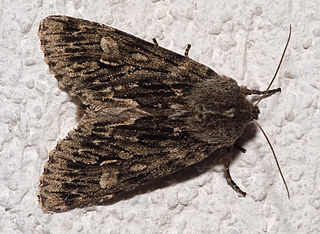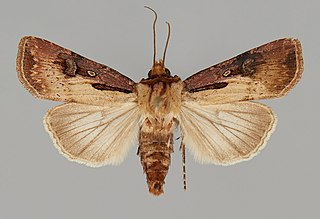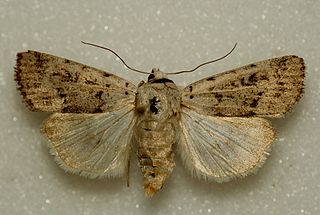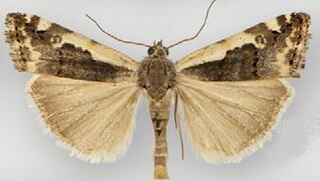
Schinia, commonly called flower moths, is a large genus of moths belonging to the family Noctuidae. The genus has a Holarctic distribution with the vast majority of species being found in North America, many with a very restricted range and larval food plant.

Brachionycha is a genus of moths of the family Noctuidae. The genus was erected by Jacob Hübner in 1819.

Euxoa medialis, the median-banded dart, is a moth of the family Noctuidae. The species was first described by Smith in 1888. It is found in North America from southern Manitoba and central Wisconsin, west to southwest Alberta and California; north to southern Alberta and south to south-central Mexico.

Agrotis obliqua is a moth of the family Noctuidae first described by Edgar Albert Smith in 1903. It is found in North America from Newfoundland to Vancouver Island, south to Colorado, Arizona and California.

Agrotis robustior is a moth of the family Noctuidae first described by Smith in 1899. It is found on the northern Great Plains of North America, the Prairie Provinces of Canada southward to South Dakota and Colorado.
Amphipoea interoceanica, the interoceanic ear moth, strawberry cutworm moth or strawberry cutworm, is a moth of the family Noctuidae first described by Smith in 1899. It is found from coast to coast in the United States. In Canada from Quebec west to Alberta, Nova Scotia.

Anicla exuberans is a moth of the family Noctuidae first described by John Bernhardt Smith in 1898. It is found in North America from central Mexico north to the dry interior of southern British Columbia, southern Alberta and south-western Saskatchewan.

Anicla tepperi is a moth of the family Noctuidae first described by Smith in 1888. It is found in North America from eastern Manitoba west to the Alberta foothills, north to about Lloydminster and south to southern Colorado.
Apamea inficita, the lined Quaker is a moth of the family Noctuidae. The species was first described by Francis Walker in 1857. It is native to North America, where it can be found from Newfoundland west to British Columbia, north to the Yukon and the Northwest Territories, and south to Colorado.
Apamea spaldingi, or Spalding's Quaker, is a moth of the family Noctuidae. The species was first described by Smith in 1909. It is native to interior western North America.
Rhizagrotis stylata is a moth of the family Noctuidae first described by John Bernhardt Smith in 1893. It is found in North America from south-eastern Alberta south to at least Arizona.

Heliothis borealis, the boreal gem, is a moth of the family Noctuidae. The species was first described by George Hampson in 1903. It is found in North America from Quebec west to Alberta, and south in the mountains to south-western Montana.
Euxoa aequalis is a moth of the family Noctuidae first described by Leon F. Harvey in 1876. It is found in Canada from British Columbia, Alberta, Saskatchewan and Yukon, south into the United States, where it has been recorded from Colorado, Wyoming and California.
Euxoa atomaris is a moth of the family Noctuidae first described by Smith in 1890. It is found in North America from North Dakota, southern Alberta and British Columbia, south to central New Mexico, Arizona and southern California.
Euxoa aurulenta, the dune cutworm, is a moth of the family Noctuidae. The species was first described by Smith in 1888. It is found in North America from Ontario west to Alberta and Washington, south to Illinois, Nebraska, Colorado and Arizona.
Diarsia calgary, the Calgary dart, is a moth of the family Noctuidae. The species was first described by Smith in 1898. It is found in North America in the mountains and foothills from Yukon, south to Arizona and New Mexico, west to the coast of British Columbia. There is a disjunct population in central western California.
Phalaenostola hanhami, also called Hanham's owlet or Hanham's snout moth, is a litter moth of the family Erebidae. The species was first described by J. B. Smith in 1899. It is found in North America from Nova Scotia, west across Canada to central Alberta, south to Massachusetts and New York.

Euxoa edictalis is a moth of the family Noctuidae first described by Smith in 1893. It is found in North America from south central Alberta and east-central Montana, west to south-central British Columbia, south to central California, southern Nevada, central Utah and western Colorado.

Tarache augustipennis, the narrow-winged midget, is a moth of the family Noctuidae. The species was first described by Augustus Radcliffe Grote in 1875. It is found in North America from Manitoba to south-western British Columbia, south to Arizona and east to Texas.

Macaria aemulataria, the common angle moth, is a moth in the family Geometridae. The species was first described by Francis Walker in 1861. It is found from Nova Scotia to Florida, west to Texas, north to Oregon and Alberta.








